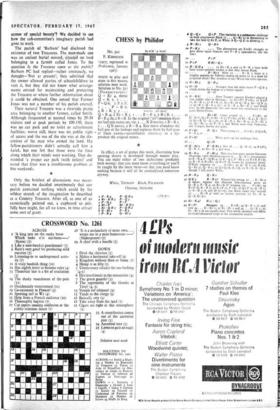Nothing to DecJare laILMPD
By STRIX
SHAKEN though it occasionally is by gusts of ineffectual indignation, our parish council is a stolid sort of body which does its best to be constructive. In theory, I suppose, parish coun- cils form the base of the great, towering, demo- cratic pyramid over whose cloud-capped apex Mr Crossman currently presides, with—still far- ther out into space—Lord Longford occupying like a cherub in a stained-glass window, a vigilant position at deep third man.
At our last meeting we were invited, by the County Countryside Sub-Committee of the County Planning and Countryside Committee, to complete a questionnaire dealing with 'Country Treasures.' These were defined as 'Those natural or man-made features of the countryside which are of public interest by reason of their aesthetic, archaeological, archi- tectural, historic, scenic, scientific, sociological or traditional interest, and whose deterioration or destruction would represent a serious loss to our heritage'; they were subdivided into 'natural' and 'man-made,' and to help us with the question- naire specimen replies to it by an imaginary parish council were provided.
We passed the various documents round and peered at them, scratching our heads. As questionnaires go, this one was an improvement on a catechism dealing with allotments which reached us some time ago and was so im- mensely complicated that we felt justified in ignoring it altogether. This time our inquisitors had gone out of their way to make it easy for us to provide the information they sought; but at no point had they indicated what they were going to do with the information when they got it, and their reference to the 'public interest' aroused our suspicions. Like many other rural parishes, we are not as devoted as perhaps we should be to the interests of the public at large. We studied the list of Country Treasures in much the same way as a traveller studies the list of contraband articles held up for his in- spection by a customs official.
We were in the clear as far as old pumping stations, early factories, battlefields, quarries, stocks and causeways went; but what about 'small houses and cottages in a village street or in the open country'? And could we decently make a nil return in respect of 'points of vantage commanding views of exceptional beauty, groups of trees of unusual beauty or interest and local scenes of special beauty'? We decided to see how the sub-committee's imaginary parish had gone to work.
The parish of 'Barham' had disclosed the existence of two Treasures. The man-made one was an ancient burial mound, situated on land belonging to a farmh called Jones. To the question Is the Treasure open to the public? Barham PC had replied—rather ominously, we thought—'Not at present'; they admitted that the owner allowed parties of schoolchildren .to visit it, but they did not know what arrange- ments existed for maintaining and protecting the Treasure or where further information about it could be obtained. One sensed that Farmer Jones was not a member of his parish council.
Their natural Treasure was a riverside picnic area belonging to another farmer, called Smith. Although frequented at normal times by 20-30 visitors and at peak periods by 100-150, there was no car park and no toilet or refreshment facilities; worse still, there was no public right of access and the use of the site was at the dis- cretion of the man who owned the land. His fellow-parishioners didn't actually call him a kulak, but one felt that those were the lines along which their minds were working. They de- manded 'a proper car park (with toilets)' and noted that litter was a troublesome problem at fine weekends.
Only the briefest of discussions was neces- sary before we decided unanimously that our parish contained nothing which could by the wildest stretch of the imagination be described as a Country Treasure. After all, as one of us casuistically pointed out, a cupboard so piti- fully bare might, for all we knew, in time attract some sort of grant.






























 Previous page
Previous page